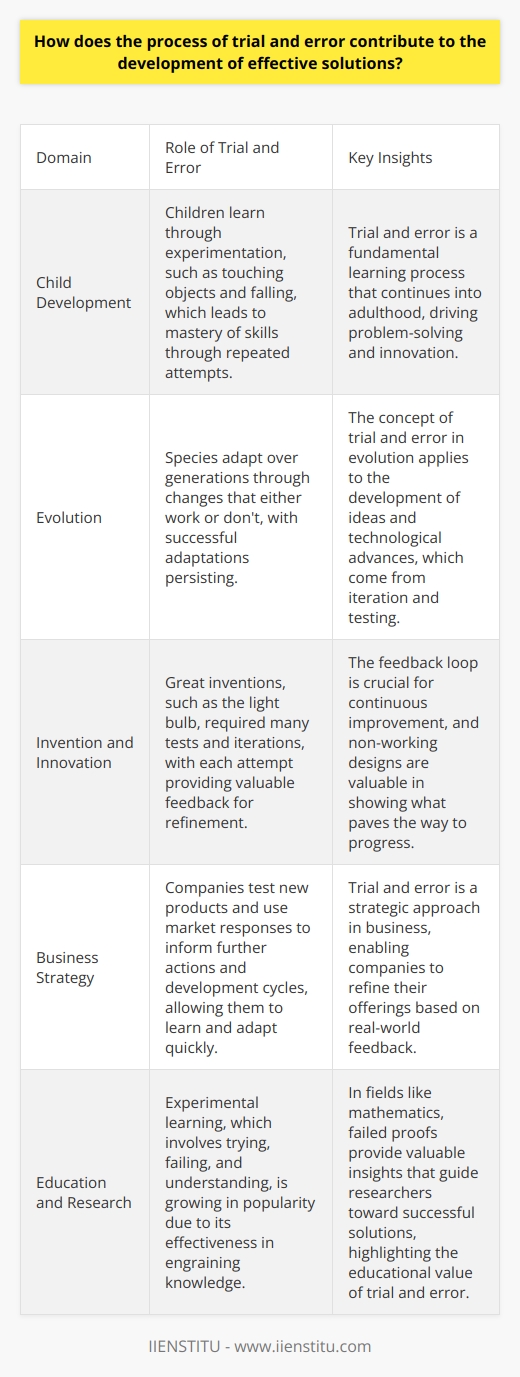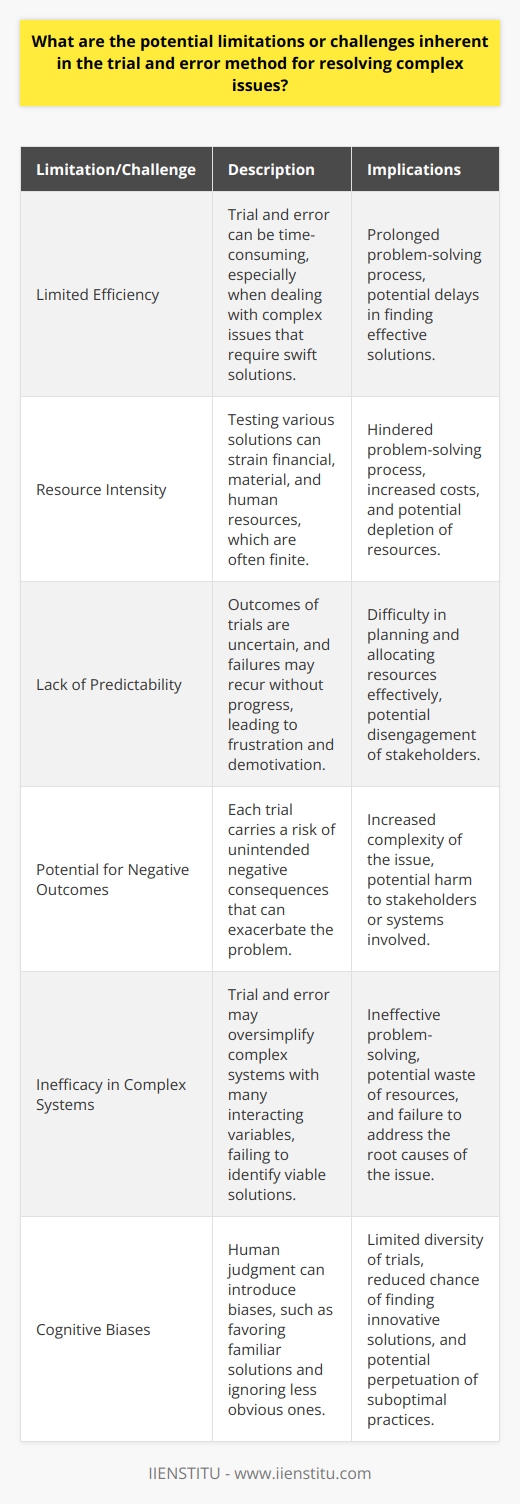
In our perpetual journey to navigate the complexities of life, problem solving emerges as a pivotal skill, essential in every walk of life from daily personal decisions to global business strategies. The art and science of problem solving encompasses a myriad of techniques, each with its strengths, suited to different scenarios. At its core, problem solving enables individuals and organizations to confront challenges and devise strategies to overcome them, thereby progressing towards desired goals. Among the various methodologies available, one that stands out for its simplicity and practicality is the trial and error method.
This fundamental approach harkens back to the most basic instincts of learning through experience and adapting to the feedback received. It is a crude yet surprisingly effective strategy that has catalyzed the discovery of various innovative solutions throughout history.
The fabric of problem solving is interwoven with patterns of thought, ranging from the highly systematic and analytic, to the more intuitive and experimental. To understand the essence of these patterns, it is critical to delve into the specifics of well-established methodologies, analyzing their suitability and effectiveness across a broad spectrum of circumstances. In this context, the trial and error method stands as an intriguing point of inquiry, providing a broad canvas for creative experimentation, and in many respects, forming the underpinning of some of the most profound breakthroughs in human endeavors. Given its significance, a focussed exploration into its mechanisms, benefits, and modern-day applications is both timely and critical.
Critical thinking and adaptability are the cornerstones of successful problem-solving endeavors, which often require a dynamic interplay between various methods. In this regard, a problem solving skills course or an online MBA course may offer pertinent frameworks and tools for honing such vital skills. These educational conduits serve as comprehensive platforms for understanding the theoretical underpinnings of various problem-solving methodologies, alongside offering practical insights through case studies and experiential learning segments.
The Essence of the Trial & Error Method
The trial and error method is a heuristic technique that traditionally involves testing various possible solutions until one that succeeds is found. It is fundamentally driven by the action-feedback loop, where an action's outcome informs the next step. This method stands as a testament to the power of persistence, with its simplicity often masking its profound capacity to untangle complex problems. It is as though through repeated attempts and iterations, the layers of a problem are gradually peeled away, revealing the seed of a solution within.
Historically, many of the greatest discoveries owe their existence to trial and error. From Thomas Edison's relentless experimentation to develop a functional light bulb to the Wright brothers' numerous attempts at achieving powered flight, trial and error has been the cradle of innovation. These narratives underscore the fact that success is often predicated upon a series of failed attempts, each providing critical information that guides subsequent efforts. The method teaches an invaluable lesson: failure is not an antithesis to success, but rather, a stepping stone towards it.
In evaluating the merits of the trial and error method against more systematic approaches, a crucial consideration is context. While systematic methods rely on predefined principles and models, trial and error thrives in scenarios where such models are inadequate or unavailable. Problems enshrouded in uncertainty or novel challenges, with no precedence, often require this heuristic approach. Consequently, its appropriateness is contingent upon the nature of the problem, the availability of resources, and the tolerance for risk and failure associated with the endeavor.
Components of the Trial & Error Method in Decision Making
Identifying the problem and establishing desired outcomes
The bedrock of any problem-solving endeavor is a clear understanding of the problem at hand and a vision of the desired outcome. This clarity is crucial as it serves as the compass guiding the trial and error process. A well-defined problem statement and outcome objectives provide a target, thereby reducing the scope of wandering aimlessly through potential solutions.
In the trial and error context, each iteration is designed to move closer to this defined target, with the feedback from each trial informing the direction of subsequent attempts.
Generating potential solutions through brainstorming
Once the problem has been succinctly defined, the next step is to generate a breadth of potential solutions without prejudice as to their viability. This brainstorming stage is where creativity and out-of-the-box thinking are encouraged, as they spawn a variety of options that may be tested. Incorporating diverse perspectives at this stage enriches the pool of ideas, thereby increasing the odds of discovering a viable solution. As a multitude of hypotheses are born, the potential pathways to success multiply, laying the groundwork for the experimental phase to commence.
Iterative process of testing and evaluating results
At the heart of the trial and error method lies the iterative process—each trial with its immediate evaluation feeding into the next. This cyclical process is predicated on the principle that learning is achieved through doing and observing the outcomes. Every iteration is an opportunity to refine the solution, discard what is ineffective, and build on what shows promise.
The documentation of results during this phase is critical, as it creates a knowledge repository that informs future attempts, not only in the immediate context but also potentially serving as a resource for other, unrelated problem-solving tasks.
The importance of flexibility and adaptability in the trial and error process
A hallmark of the trial and error method is its inherent demand for flexibility and adaptability. Each trial serves as a mini-experiment; hence, the problem solver must be willing to pivot and adjust approaches based on the feedback received. In scenarios where a rigid mindset prevails, there is a propensity to cling to failing solutions due to sunk cost fallacies or cognitive biases. It is the ability to let go of ineffective solutions and the agility to adopt new directions that often differentiate between prolonged struggles and the swift attainment of objectives. The trial and error process, therefore, greatly benefits those who view problem solving as a dynamic and evolving journey.
Effective Solutions Through Trial & Error
Advantages of employing trial and error in solution finding
Root Cause İdentification Techniques For Effective Decision Making
Root Cause Analysis Techniques For Effective Problem Solving
One of the compelling advantages of the trial and error method is its capacity to foster creativity and innovation. As it encourages a broad exploration of potential solutions, it inherently creates room for serendipitous discoveries—those happy accidents that might never have surfaced through a more regimented approach. Furthermore, trial and error is particularly suited to addressing uncertain or complex situations where variables cannot be easily controlled or predicted. Here, the method shines, capable of navigating uncharted territories and adapting in real-time to emerging insights.
Case studies exemplifying the success of trial and error
A look into multiple domains reveals case studies that exemplify the success of trial and error. In the pharmaceutical industry, drug discovery often depends on this method, with numerous compounds being synthesized and tested before arriving at a successful treatment. In technology startups, the lean startup methodology, with its built-in cycles of build-measure-learn, echoes the ethos of trial and error, and has led to the successful iteration of products in response to user feedback. These instances highlight that the method is not merely about guesswork but is a disciplined approach to discovering effective solutions through structured experimentation.
Learning from failures: How mistakes contribute to optimal decision making
A less immediately apparent benefit of trial and error is its role in learning from failures. By examining the reasons behind unsuccessful trials, valuable insights emerge that refine the decision-making process. In this sense, each mistake becomes a lesson, contributing to a deeper understanding of the problem and mitigating the likelihood of repeating the same errors. This process of iterative learning is indispensable in the pursuit of optimal solutions, and it reinforces the concept that progress is often incremental, composed of many small advancements rather than singular leaps.
Trial & Error in Modern-Day Applications
Application of trial and error in technology and development
In the realm of technology and development, the trial and error method is omnipresent. Rapid prototyping, for instance, incorporates this approach, allowing designers and engineers to quickly iterate on product designs to optimize usability and functionality. Iterative software development methodologies, such as Agile, are also grounded in the principles of trial and error, emphasizing quick, incremental releases and refinement in response to user interaction. These modern applications showcase the adaptability of the method, demonstrating its relevance in the fast-paced, innovation-driven landscape of technology.
The role of trial and error in entrepreneurial ventures
Entrepreneurship inherently involves navigating through uncertainty and risk, making trial and error a method of choice for many founders. The story of successful ventures often includes a historical path rife with pivots, revisions, and lessons learned through failed attempts. In these ventures, embracing the trial and error approach can facilitate the discovery of market fit and unique selling propositions that distinguish the venture and offer competitive advantages.
Integrating trial and error into personal decision-making processes
The application of trial and error also extends into the realm of personal decision-making. Personal growth and career development, for instance, can benefit from an experimental approach where individuals try different roles, projects, or strategies to find the best alignment with their skills and passions. By viewing each experience as a test run, one gains a richer understanding of their preferences and capabilities, which can be leveraged to make more informed and effective decisions about their future endeavors.
Strategies for Optimizing the Trial & Error Method
Setting parameters and constraints to increase efficiency
While a degree of freedom is crucial for trial and error, setting parameters and constraints can increase efficiency and focus the experimentation process. By establishing clear criteria for what constitutes a viable solution and delineating boundaries within which trials should occur, problem solvers can mitigate aimlessness and expedite the discovery of effective solutions. These constraints might relate to resource allocation, time frames, or specific outcome metrics that need to be met.
Employing feedback mechanisms for continuous improvement
The implementation of structured feedback mechanisms enhances the trial and error method, bolstering its effectiveness. These mechanisms can include data collection and analysis, peer reviews, or user testing, depending on the context. The data derived from these feedback loops provides an empirical basis for decision making, enabling a more refined approach to trialing new solutions, and ensuring that iterations are informed by solid evidence.
Balancing risk with potential rewards in trial and error experimentation
Balancing risk with potential rewards is a strategic consideration in optimizing the trial and error method. Calculated risks are often necessary to uncover unconventional solutions, but they must be weighed against the possible benefits. A pragmatic approach to risk involves setting limits on the scope and scale of trials to ensure that, even in the event of failure, the damage is contained and learnings can be accrued without catastrophic consequences.
Conclusion: The Future of Trial & Error in Problem Solving
In an ever-changing world, marked by new challenges and the continuous evolution of knowledge, the trial and error method retains its enduring relevance. Its proven track record across various fields and the inherent human propensity to learn through trial underscore its future potential. The method's capacity to navigate through ambiguity and adapt to unforeseen obstacles positions it as an invaluable tool in the problem solver's arsenal.
Embracing the trial and error mindset translates into a broadened tolerance for uncertainty and a more resilient approach to confronting challenges. The interplay between perseverance and resilience is often the engine powering the journey to effective solutions, with every falter providing a new vantage point from which success may be glimpsed. As we forge ahead, cultivating these qualities and nurturing the trial and error approach will undoubtedly contribute to the sophistication of problem-solving practices and the broadening of possibilities.
In the spirit of embracing this timeless methodology, there is an invitation for individuals to reflect on their personal experiences with trial and error. Sharing such narratives not only enriches the communal understanding of the method but also offers reassurance that others share in the struggle and the triumph embedded in the problem-solving journey.
Frequently Asked Questions
What are the underlying principles of the trial and error method in problem-solving?
Trial and Error: Guiding Tenets
Problem-Solving Fundamentals
Trial and error stands as a fundamental problem-solving strategy. It appeals due to its simplicity and directness. One confronts a problem. One then generates potential solutions. One tests these solutions until success emerges.
Iteration Drives Progress
The method relies heavily on iterative processes. Iteration here means repeated attempts. Through repetition, one gains insights. Understanding deepens. One adapts strategies accordingly.
Feedback Is Crucial
Feedback informs the process. Positive feedback signals a step towards success. Negative feedback prompts a strategy shift. Each outcome informs the next attempt.
Adaptability Enhances Success
Adaptability proves essential within this framework. Challenges often demand flexible thinking. New information can prompt strategy changes. Adaptability turns setbacks into learning opportunities.
Learning From Failure
Each failure teaches valuable lessons. Failures highlight what does not work. Learning from these eliminates inefficient paths. It underscores the power of resilience.
Heuristic Value
Trial and error carries heuristic value. Heuristics guide problem-solving via experiential learning. They offer practical approaches when theoretical knowledge falls short. Through heuristics, one accrues wisdom.
Incremental Problem-Solving
The approach facilitates incremental problem-solving. Small steps lead to solutions. Each successful step builds upon the last. Complexity becomes manageable when broken down.
The Role of Persistence
Persistence anchors the trial and error method. Persistence means ongoing efforts despite failures. It embodies the conviction that a solution exists. Without persistence, premature abandonment may occur.
In conclusion, trial and error formulates a strategy centered around iteration, adaptability, and learning from failures. It leverages feedback, employs heuristics, and relies on incremental progress. Above all, it demands persistence, for often, success lies just beyond the last failed attempt.

How does the process of trial and error contribute to the development of effective solutions?
The Significance of Trial and Error
Trial and error characterizes learning by experimenting. This approach drives discovery. Humans rely on this method across disciplines. It springs from our innate curiosity. In essence, it fuels innovation.
The Basis of Learning
Children learn through trial and error. They touch, they fall. They adjust; they thrive. Repeated attempts lead to mastery. This reflects in adult problem-solving too. We guess, we try. We fail, we learn.
Problem-solving involves this iterative process. Effective solutions emerge from numerous attempts. Not all attempts yield success. However, each failed attempt brings insight. This insight is crucial for refinement.
Adaptation and Evolution
Evolution exemplifies trial and error. Species adapt over generations. Changes either work or don't. Successful adaptations persist. The same concept applies to ideas.
Technological advances come from iteration. Engineers build, test, and evaluate. Non-working designs are valuable. They show what paves the way to progress.
Innovation Through Iteration
Great inventions didn't happen instantly. The light bulb took many tests. Each iteration provided Edison valuable feedback. Feedback loop is fundamental. Continuous improvement cannot happen without it.
In business, trial and error is strategic. Companies test new products. Market responses dictate further actions. This informs the development cycle. Businesses learn and adapt quickly.
The Educational Value
Education systems are recognizing this learning form's value. Experimental learning grows in popularity. Students try, fail, and understand. This process engrains knowledge.
In mathematics, we conjecture and prove. Solutions don't come immediately. Failed proofs teach us much. They guide toward a successful proof.
In Conclusion
Trial and error underpins problem-solving. This process encourages resilient attitudes. Adversity becomes a learning opportunity. We refine our methods. We inch closer to efficacy. Persistence becomes synonymous with success. Trial and error thus shapes effective solutions.

What are the potential limitations or challenges inherent in the trial and error method for resolving complex issues?
Understanding Trial and Error
The trial and error method involves experimentation. Researchers test various solutions. They learn from mistakes. Over time, they may find success. Yet, this approach has limitations. Such challenges often emerge in complex issues. They require careful consideration.
Limited Efficiency
Trial and error are not always efficient. Time is a critical factor. Complex problems demand swift solutions. Trial and error can take longer. It involves testing multiple scenarios. Some situations cannot wait.
Resource Intensity
Resources are another concern. They often are finite. Testing various solutions uses them up. Financial, material, and human resources get taxed. This strain can hinder the process.
Lack of Predictability
Predictability is low in this method. Outcomes are uncertain. Failures may recur without progress. It is a method without assurances. This unpredictability can lead to frustration. It can demotivate those involved.
Potential for Negative Outcomes
Every trial carries risk. Some might have negative consequences. These can exacerbate the problem. The aim is to solve, not complicate. Yet, unintended effects can emerge. This makes the method risky.
Inefficacy in Complex Systems
Complex systems have many variables. They interact in unpredictable ways. A trial and error approach might oversimplify. It may not account for system complexities. Thus, it can fail to identify viable solutions.
Cognitive Biases
Human judgment can introduce bias. Decision-makers might favor familiar solutions. They may ignore less obvious ones. This can limit the diversity of trials. It reduces the chance of finding innovative solutions.
Discouragement and Persistence Challenges
Persistence is key in trial and error. Yet, repeated failures can lead to discouragement. Stakeholders might give up too soon. They may not sustain effort over time. This can prevent finding a successful trial.
Ethical and Societal Considerations
Ethical implications matter. Trial and error can affect people's lives. Societal implications must be a concern. The risks must be justified. Stakeholders should consider the greater good.
The Need for a Strategic Approach
A purely trial and error method is simplistic. Complex issues often need strategic thinking. This involves planning and foresight. It entails understanding systems. It requires more than random testing.
Summary
The trial and error method has inherent challenges. It must be used judiciously. Efficiency, resource allocation, and ethics are essential concerns. Complex problems often require more than repeated attempts. They need thoughtful, systematic approaches. Trial and error can be part of this process. But it should not stand alone. It functions best when combined with analytical methods. This union can yield better, more sustainable solutions.



